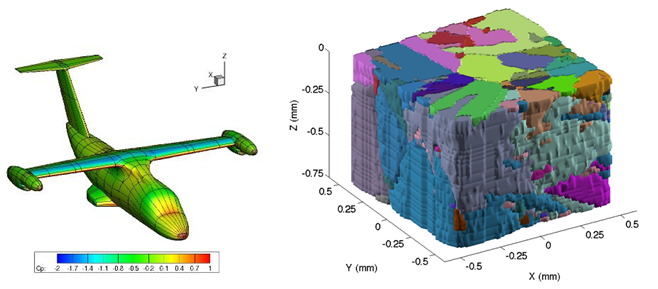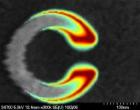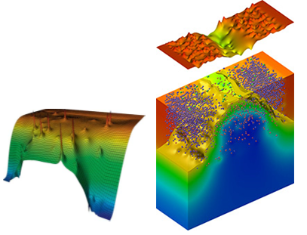Modelling & Design
Modelling and design is an interdisciplinary activity, spanning mathematics and statistics, computing science and engineering. A model allows us to create a mathematical representation the system under investigation. The model is approximately solved on a computer. The simulation can be used to predict the properties and behaviour of the system over time and under different conditions. The surrogate computational model underpins virtual design where a product is tested and optimised numerically prior to fabrication. Combined computational modelling and design allows for the rapid and affordable engineering of efficient solutions to challenging problems in manufacturing.
Key Contact: Prof. Chris Pearce
Key manufacturing sectors supported
Aerospace
Research expertise in modelling and design relevant to manufacturing includes the modelling, simulation and control of complex systems, materials and structures, intelligent and autonomous systems, and aerodynamics and fluid mechanics. Applications of the research include developing models to compute the loading on wind turbines, helicopters blades, and novel aircraft.
Computational modelling also underpins research into understanding and characterising aerospace materials for industrial partners.

Biomedical and Healthcare
The modelling and design techniques developed and used in Biomedical Engineering play a key role in translating research to manufactured products. The research areas where modelling is ubiquitous include Advanced Medical Diagnostics, Rehabilitation Engineering and Assistive Technologies, Biomaterials and Synthetic Biology.

Safety Critical Applications
Virtual design plays a key role in the design of safety critical applications. Research expertise in this area includes the mechanics of solids at various length scales, multiphysics problems, granular flow, and the development of numerical methods and modelling tools. The modelling tools are utilised in the nuclear sector where virtual design and testing have obvious benefits.
Semiconductor Industry
The Device Modelling Group develops advanced computational modelling tools to provide deep insight into the operation of modern semiconductor devices and circuits, and thereby dramatically reduces the development costs and time-to-market. A spin-out company from the Group (acquired by Synopsis) develops world-leading technology that could save the semiconductor industry billions of pounds from silicon chip failure by predicting how performance will be affected in future generations of miniature transistors.

Projects
EP/M002519/1 Flexible Electronic Device Modelling
EP/N014642/1: EPSRC centre for Multiscale Soft Tissue Mechanics- with application to heart & cancer
GR/S91024/01 Improved Inverse Simulation using Nonlinear Predictive Methods
EP/E504876/1 Mathematic modelling and computational methods in solid mechanics
Case Studies
Gold Standard Simulations acquired by leading software company Synopsys
Spin-out company Gold Standard Simulations was launched in 2010 by the University of Glasgow and in 2016 was acquired by the California-based company Synopsys Inc., a global leader in electronic design automation (EDA) and semiconductor IP, and the world’s 15th largest software company.
Gold Standard Simulations Ltd (GSS) was set up in 2010, with £720,000 seed funding and ongoing commercialisation support from Scottish Enterprise, to commercialise more than 20 years of research in modelling and simulation of advanced transistors and circuits for semiconductor microchips. GSS specialises in predictive physical simulation of performance and atomic scale transistor variability, and statistical “compact” models for circuit simulation.
The GSS automated tool chain predicts variations in the performance of next generation transistors up to two years before they come to market, allowing the semiconductor manufacturers to optimise their designs in order to improve performance and yield. This enabled the semiconductor industry to reduce time and cost when developing next-generation semiconductor process technologies and corresponding circuits and systems. This has become increasingly important due to the broadening of technology options, increasing complexity of transistor and circuit operations and the need for technology tuning for particular commercial applications.
GSS was created by Professor Asen Asenov, James Watt Chair in Electrical Engineering in the College of Science and Engineering, with support from the University and Scottish Enterprise.
According to Synopsys: “The acquisition of GSS supports the Synopsys TCAD strategy to offer a comprehensive solution to reduce development time and cost for advanced node development by enabling the evaluation and selection of process, device and materials options in the pre-wafer research phases of development.”

